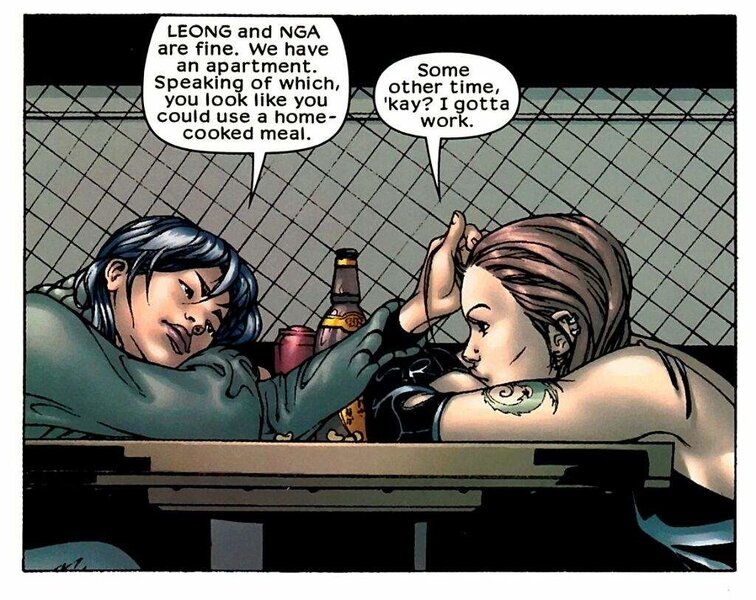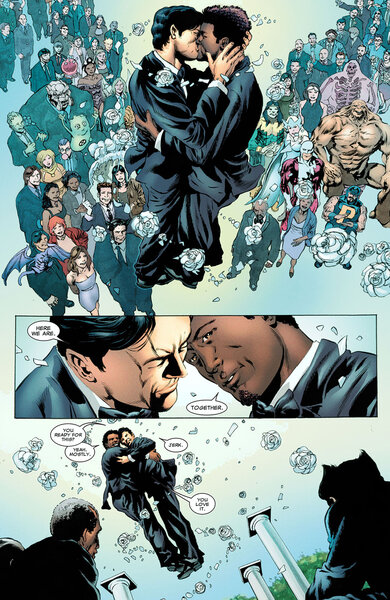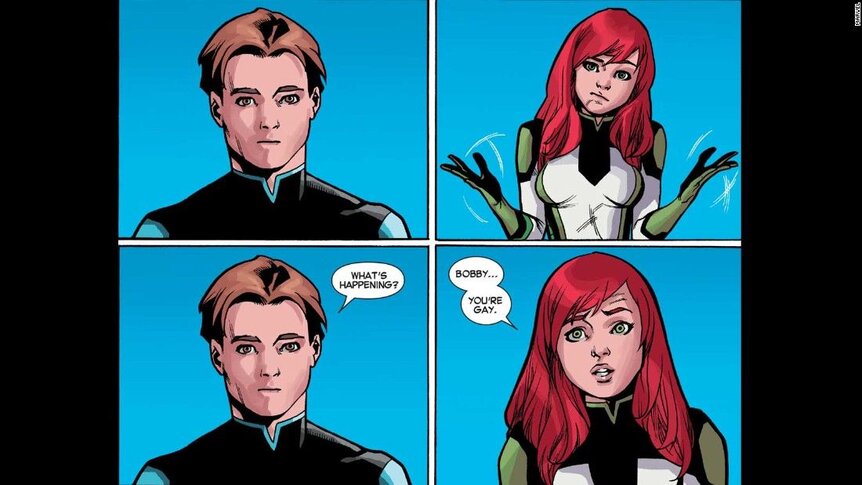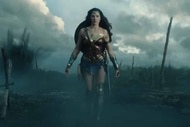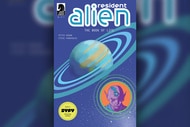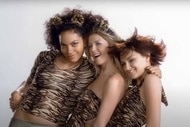Create a free profile to get unlimited access to exclusive videos, sweepstakes, and more!
X-Men as a queer metaphor

The X-Men have been oft-cited as a parallel for the civil rights movement, but as a tale focused around five white prep school kids, it is true that some of the gravity of the situation was lost in translation. However, the X-Men have changed vastly over the years, and this basis has given countless writers and artists the opportunity to tackle heavy subjects like classism, racism, homophobia, and ableism through mainstream comics. The downside to this, of course, is that those things usually appear as a metaphor only, and representation still has a long way to go.
Still, compared to other mainstream comics, the X-Men have always been remarkably progressive. This franchise is a rarity in how consistently it has focused on highlighting the fallacy of bigotry as a major obstacle in its character’s lives, and portraying all forms of intolerance as being deeply wrong. That is what has drawn such a wide audience to X-Men, and it is what makes it stand out for so many readers. Outsiders have always flocked to this concept, and for very obvious reasons.
The Mutant Metaphor
The early years of the X-Men were fairly low on significant social commentary beyond the basic elements of its premise. Indeed, the initial comparison between Xavier and Magneto and MLK and Malcolm X gives an extremely lopsided view of the beliefs of both activists. Magneto being painted as an extremist and mutant supremacist and comparing that to Malcolm X is obviously problematic, as Malcolm X wasn’t doing things like attempting to knock the Earth off its axis with the power of magnetism, nor did MLK’s outlook bear the same naivete as Professor Xavier’s. If we detach the X-Men from this notion that it in any way resembles these real-life people and scenarios, we are given a cast of relatable characters who experience a fictionalized version of oppression, and that has drawn countless people to the franchise that experience the real world equivalent, but without the cool superpowers.
It is true that comparisons between the civil rights movement in the ‘60s and the very fictional X-Men of the ‘60s don’t fare particularly well, but that isn’t where the metaphor ended. Implications and references to homosexuality began to appear more prominently after the early ‘80s. In God Loves Man Kills a bigoted preacher named Stryker uses a campaign much like the Lavender Scare to declare that mutants are always hiding among the “decent, ordinary” people of the world, posing an invisible threat. Still, actual mention of queer characters was non-existent through this time, and indeed there was a great deal of suppression of queer subject matter at Marvel.
Well into the ‘80s, more and more queer subtext was played out on the pages: Illyana Rasputin and Kitty Pryde wrestling with each other in bed; Storm and Yukio's fling; Mystique and Destiny appearing only in tangent to one another; Northstar’s lack of interest in women; Rachel Summers in her entirety... there was a lot of implied queerness in Claremont’s X-Men run.
In the '90s, the Legacy Virus appeared as an analog to AIDS during a time when it was the leading cause of death for queer men (although, of course, it was primarily straight characters who were affected in the fictional world of the X-Men). Many mutants died as a result of this. Like HIV, it was viewed as a disease that only affected specific people until eventually Moira MacTaggert was infected and slowly perished to the illness. Again, this analog doesn’t begin to convey the sheer impact of AIDS It fails to provide sufficient comment on the demonization of gay men in the United States during the ‘80s, and it doesn't even begin to address the subsequent communities all around the world that have been affected by the crisis. Ignoring the real world fact that specific communities are more vulnerable than others allowed it to become an umbrella issue that could hurt mutants of all class backgrounds on equal footing, thus again missing much of the horror behind the real world events on which the story was based. On one hand, this makes sense in a book aimed at young folks, but on the other, it flattens a complex issue.
Suppression of Queer Characters
As much as X-Men has appealed to queer audiences over the years, actual queer representation in their pages has been fairly low. While there are more queer characters per capita than in most franchises, a lot of these characters vanish from their respective titles right around the time they're written as not-straight.
Northstar was the first X-Man to come out via the X-Men adjacent book Alpha Flight, though he wouldn’t achieve official X-Man status for years to come. In 1992, a queer superhero was unheard of, although Northstar had been written as queer from the start in subtextual ways. His coming out story reads back as a series of tropes via today’s lens, but obviously, there’s no overstating the influence of the storyline on queer readers. Unfortunately, that was the last mention of Northstar’s homosexuality for years. He had a mini-series that came and went without a single nod to the story, and indeed he didn't discuss his sexuality again until he joined the X-Men. He was married to his boyfriend Kyle in 2012 but has seldom appeared in a prominent role over the last several years. Still, we recently saw him become active once more in the Age of X-Man book, the X-Tremists, and as prominent queer X-Men go, Northstar has always been one of the most visible.
Meanwhile, Mystique is another character who was written as queer from her first appearances in Ms. Marvel in the late ‘70s, wherein she adopted Rogue alongside her partner, Destiny. When she shows up as a nemesis for Carol Danvers, it is because Destiny has warned her that Carol poses a danger to Rogue and their lives together. Enraged, Mystique attacks Carol through those closest to her, actually maiming one of her boyfriends. For years, anytime Mystique showed up in a comic, chances are Destiny would be by their side. Nightcrawler was ultimately revealed to have been Mystique’s son, but the original idea had centered around Mystique, in male form, as Nightcrawler’s father, with Destiny as his mother. Even if only rating by the premise of what is a better story, Mystique and Destiny win by a landslide. As it currently stands, Nightcrawler’s dad is a demon, though it’s fairly likely this will eventually be retconned.
Without ever stating the two of them as a couple, the X-Men comics of Mystique’s early days still managed to imply a tenderness that went beyond friendship between them. Destiny was eventually killed in battle by Xavier’s son Legion, and her death had a devastating effect on Mystique. There have been some stories that honored her memory of her lost love. In The Wolverines — still shown without context — Mystique was willing to sacrifice everyone and everything just because it meant she could be with Destiny again.
Mystique has been a hypersexualized seducer of men in many of her comic book appearances since Destiny’s death, and while that isn’t inherently a bad thing, it has a tendency to distract writers and readers away from other interesting aspects of her character. Her stories have distanced her from the discussion of her queerness and her potential status as a non-binary character so much as to render it non-existent. Mystique has seldom been given the deeper focus she deserves, even after years of stories in which she appeared as a prominent character. Her relationship with Destiny is still referred to in the context of close friendship in most stories.
Iceman is perhaps one of the most interesting coming out stories of the X-Men. As early as his appearances in the New Defenders, Bobby was seen struggling with his masculinity. He made jokes about being a homosexual, calling himself “Lance, Warren’s boyfriend” and was unable to connect with women, often going over-the-top in his flirtations in a way that can only read back as overcompensation. When the gender non-conforming character Cloud shifted genders and openly flirted with Bobby, it made him so uncomfortable that he had to leave the room, and later he was verbally cruel to Cloud about their ability to change.
Bobby disguised his own powers in a way that readers weren’t in on until Emma Frost briefly possessed his body and unlocked unfathomable levels that Bobby himself had never even come close to reaching. Dismayed by what she perceived as his laziness, she scolded Bobby, but this is one place in which his desire to hold back and hide parts of himself became the most glaringly obvious. Years later, Jean Grey quite tactlessly outed Bobby by reading his mind and casually announcing his own thoughts to him, telling him no one cared, which is not exactly compassionate when speaking to someone who cares so much that he was closeted for most of his life. Iceman went on to have his own ongoing series where his sexuality was further explored.
Unresolved Subtext
Rictor and Shatterstar were the first to share a same-sex kiss in Marvel comics. Even as recently as the Shatterstar series and though their relationship has always been complicated, they remain devoted to one another and are easily one of the great love stories of Marvel. But theirs is one of the few stories to exist beyond hints and whispers.
Storm, Kitty Pryde, and Rachel Summers have all been hinted as queer for decades at this point with little pay-off. Meanwhile, Illyana was shown kissing Leah of Hel quite recently with little follow-up. Where that relationship is going or if we’ll ever see it again remains unclear. With these characters, the subtext is overwhelming, but it’s hard to say if they’ll ever be in open same-sex relationships or if any of them will have the freedom to explore their gender identities going forward.
Psylocke was established as bisexual in a recent run of Uncanny X-Force, but the story brief to say the least. The antihero Fantomex split into three separate personalities, including one named Cluster who appeared in a feminine form. Tired of Fantomex's childish antics, Psylocke began a relationship with Cluster. This was easily one of the most interesting things to happen in that entire series, but unfortunately, the storyline just sort of faded out and hasn’t been revisited. Psylocke has gained increased prominence in the X-Universe, but her complicated view of her own relationships has been less explored.
There have been other examples of queer characters and story arcs in the X-Men, such as Karma, Stacy-X, Anole, Daken, and others. Deadpool and Gambit have both been hinted as being pansexual, but it could take decades for that to play out, if it ever does. There have been brief appearances of alternate reality queer characters from Colossus to Wolverine to Beast and beyond, but being from other worlds naturally entails brevity of storyline. Yet, the queer fandom around the X-Men continues to explode with new queer creators producing some of the best X-Stories in years. In the end, hiring more queer creators will always be key in well-written queer characters.
The X-Men narratives have made frequent use of the comparison to queer people in its long history, but the actual on-page representation of queer characters still leaves something to be desired. Even through its missteps, X-Men is beacon for millions of people all across the globe who know what it’s like to be judged for who they are, or who have had to hide something about themselves that the majority of humanity might not understand. Countless are the stories of the outsider that discovered the X-Men at an important time in their adolescence and found a sense of belonging, and for that, the X-Men remains a hugely important franchise.
